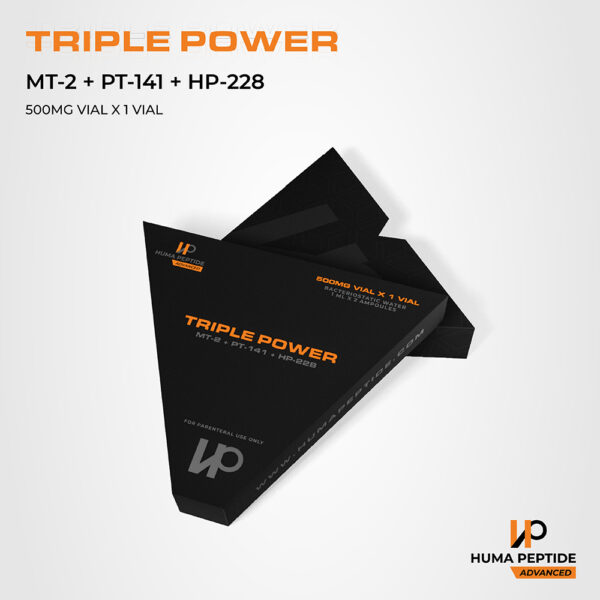Description
| QUANTITY | COMPOSITION | |
| Triple Power | 500mg Vial X 1 Vial | Melanotan-2 : 5mg PT-141 : 5mg HP-288 : 490mg |
| Bacteriostatic Water | 1ml x 2 Ampoules | Methylparaben : 0.12% Propylparaben : 0.012% pH : 4.5-7.0 |
What Is Melanotan 2 (MT-2)?
Melanotan 2 (MT-2) is a synthetic version of human alpha-melanocyte-stimulating hormone (α-MSH). It was originally developed in the 1980s, at the University of Arizona, after it was found that α-MSH caused sexual arousal in rodents as well as darkening of the skin. Originally designed as a sunless tanning option, MT-2 was eventually found to have a wide range of effects such as:
- increasing sexual arousal,
- promoting tanning or skin pigmentation,
- reducing compulsive behavior,
- controlling addiction,
- fighting hunger,
- reducing glucagon production, and
- reversing features of autism.
Melanotan 2 Peptide Structure
Peptide Sequence: Nle-Asp(1)-His-D-Phe-Arg-Trp-Lys(1)
Molecular Formula: C50H69N15O9
Molecular Weight: 1024.198 g/mol
PubChem CID: 92432
CAS Number: 121062-08-6
What Is PT-141?
PT-141, also called bremelanotide, is sometimes referred to as the female Viagra because the peptide was previously investigated in phase IIb human clinical trials for use in treating female hypoactive sexual desire disorder (HSDD). PT-141 is a melanocortin that binds primarily to melanocortin 4 receptor (MC-4R) and MC-1R. In 2009, PT-141 was also investigated as a treatment for acute hemorrhage. PT-141 is a derivative of another synthetic melanocortin, melanotan 2 (MT-2).
PT-141 Molecular Structure
Sequence: Ac-Nle-Asp(1)-His-D-Phe-Arg-Trp-Lys(1)
Molecular Formula: C50H68N14O10
Molecular Weight: 1025.182 g/mol
PubChem CID: 9941379
CAS Number: 189691-06-3
What Is HP228?
HP-228, a novel synthetic peptide, inhibits the induction of nitric oxide synthase in vivo but not in vitro
Alpha-Melanocyte stimulating hormone has been shown to prevent endotoxin shock. A heptapeptide analog (HP-228) has recently been synthesized and shown to be an even more potent protective agent. Because the hypotensive and toxic actions of lipopolysaccharide (LPS) appear to involve the induction of type II nitric oxide synthase (iNOS), we have examined the actions of HP-228 on nitric oxide production using an endotoxemia model in conscious rats given E. coli LPS (5 mg/kg i.v.) and monitored for 6 h. A group of rats received HP-228 (30 micrograms/kg) 30 min before LPS. Using nitro L-arginine methyl ester-sensitive cGMP production as an estimate of nitric oxide synthase activity in aortic segments, ex vivo, we determined that LPS increases iNOS activity and that HP-228 pretreatment markedly reduces this response. Additionally, the rate of conversion of 3[H]-arginine to 3[H]-citrulline was significantly reduced in lung homogenates from HP-228-treated rats. HP-228 did not alter the activity of the constitutive nitric oxide synthase in aortic rings or in cerebella. In isolated rat aortic smooth muscle cells, LPS or interleukin-1 beta caused prominent rises in nitric oxide generated by iNOS. HP-228 did not antagonize the effect of these inducing agents. However, in these cells, plasma obtained from rats 1 h after administration of HP-228 prevented the induction of iNOS by both LPS and interleukin-1 beta. In conclusion, HP-228 prevents the in vivo induction of nitric oxide synthase by LPS


















Reviews
There are no reviews yet.